Is South Korea the Next Emerging Early Phase Destination?
The developed markets of North America and Europe together saw approximately 81% of the Phase I trial share in 2013 which is a 6% increase from 2012. Trials
The developed markets of North America and Europe together saw approximately 81% of the Phase I trial share in 2013 which is a 6% increase from 2012. Trials from emerging markets of South Korea and Russia also saw a 5% increase in 2013, showing the increased conduct of trials in these markets.1 Prior to implementing a new market entry strategy, it is important for category managers of pharmaceutical companies to include an emerging market sourcing analysis as part of their category plan. Supply market, regulatory and risk factors are the key parameters that are considered during the analysis with supplier availability and patient pool falling under the supply market factors, regulatory timeline and country risk falling under the regulatory & risk factors. Through this analysis, South Korea is found to be the most attractive early phase destination based on the availability of global and regional suppliers, patient pool and the current regulatory scenario of the country. Russia and China follows as the next attractive destination with regulatory stringencies being a current problem.
Early Phase Clinical Trial Market:
The Early Phase Clinical Trial market is estimated at USD 11.9 billion in 2013 and is expected to grow at a CAGR of 1.5% to 2%
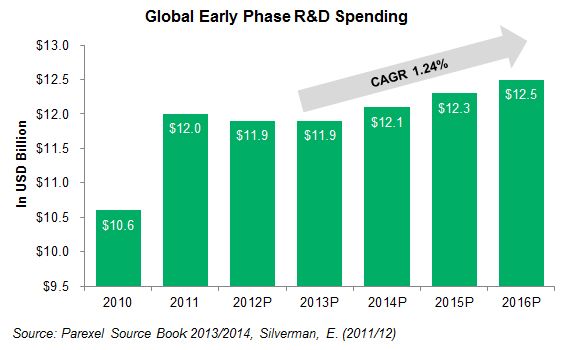
The growth rate is expected to reach 4% by 2018 mainly due to increased emphasis on drug safety data, new demand for health economic and outcomes research and shift towards personalized medicine and orphan drug development.3
In 2013, the developed markets of North America and Europe together saw approximately 81% of the Phase I trial share which is a 5% increase from 2012. Trials from South Korea and Russia have also increased by 5% from 2012, showing the increased conduct of trials in emerging markets.

On the other hand, India saw a decline in First-In-Human (FIH) Phase I trials as a recent of stringent regulations leading to the shut down of Phase I unit of CROs.4
Australia, China, Russia, South Korea, Singapore and Australia saw an overall increase in Phase I trials through 2011 and 2013 with a minimum CAGR of 1.56 % for Australia and highest CAGR of 32.15% for Russia’s

Emerging Country Sourcing Analysis. This has led to these countries arising as the next emerging destinations for Phase I trials after North America and Europe.
Before implementing a strategic plan to source clinical services from emerging countries, it is important to understand the supply market and regulatory & risk scenario in these markets. Now that we have identified Australia, China, Russia, South Korea and Singapore as the emerging destinations for clinical trial conduct, let us look into the key supply market and regulatory & risk parameters that need to be considered while carrying out a sourcing analysis.
Supply Market Factors
The two most important factors determining the strength of the supply market is the number of suppliers who can provide Phase I services to big pharma, and the patient pool availability for conducting clinical trials. These include the following parameters:
Supplier Availability
Supplier availability refers to the number of suppliers available in the market who have the capability and scale to cater to Phase I services of big pharma. The first step to supply market analysis involves identification of key suppliers. The same is carried out for all the emerging countries and depicted in the figure below
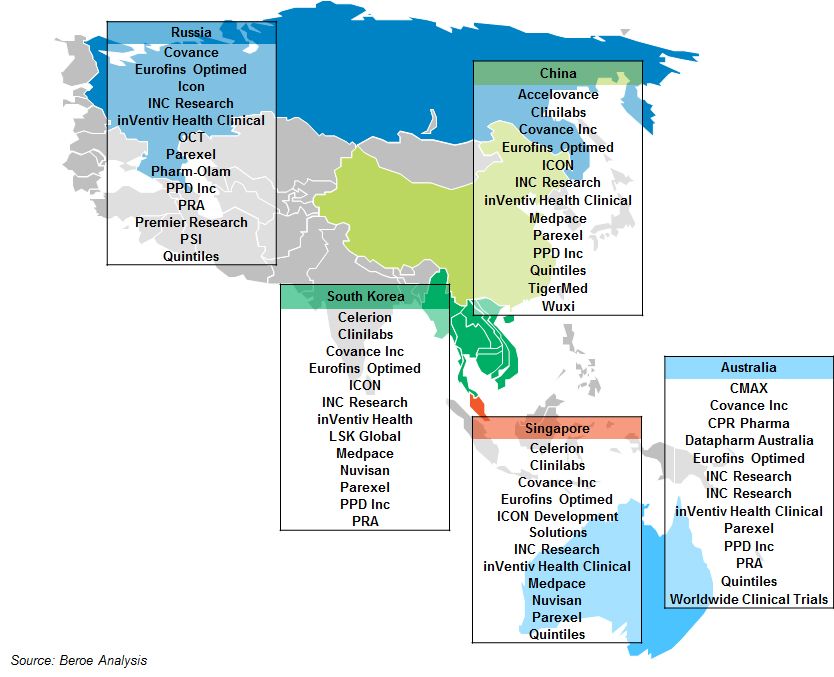
Following key supplier identification, determining the level of market concentration is important as it affects the negotiating power of buyers.5 The early phase market comprises of numerous suppliers with about 15 of them holding greater than 50% market share compared to the rest. The degree of market concentration for early phase is between 2 – 2.7; hence falling under the monopolistic competition where service differentiation between suppliers is less and barriers to entry are limited. This leaves the concentration of this market on a medium level where price is a function of supply and demand and the ability of a supplier to obtain greater market share is due to innovative technology, unique bundling that helps in synergies and strategic partnerships. The market concentration ratios relate to the industry concentration ratio and the R&D investment big pharma spend towards early phase trials.
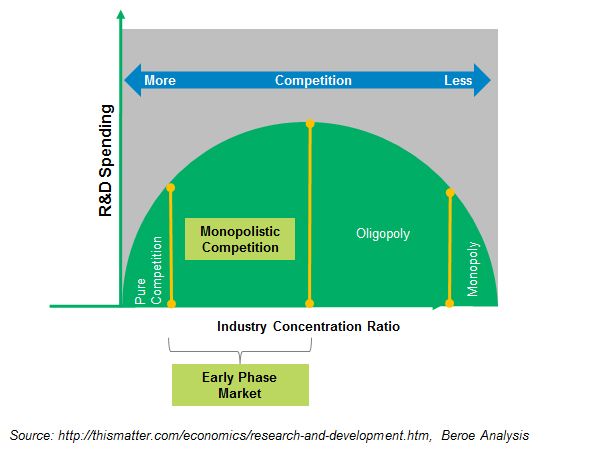
Early phase clinical trial service as a category has been viewed as strategic by pharmaceutical companies due to a high level of risk involved in terms of complexity of trials, regulatory compliance, and impact on cost of trial conduct. Since every big pharma is competing with each other to bring the drug to market, they invest an approximate USD 12 billion on conducting early phase trials wherein USD 8.2 billion of the spend is outsourced majorly to CRO’s and a part of it to academic universities.2 This clearly places early phase market under the monopolistic competition curve.
Patient Pool
Understanding the patient pool in a given region is important as understanding the number of treatable patients available for trial conduct determines the success of patient recruitment respectively. The urban population and the treatment naïve populations of countries need to be considered as base while considering the patient pool in that particular region. Furthermore, the patient pool access available in a given country among the suppliers is needed. Based on these two dynamics, the below heat map is drawn for the emerging countries
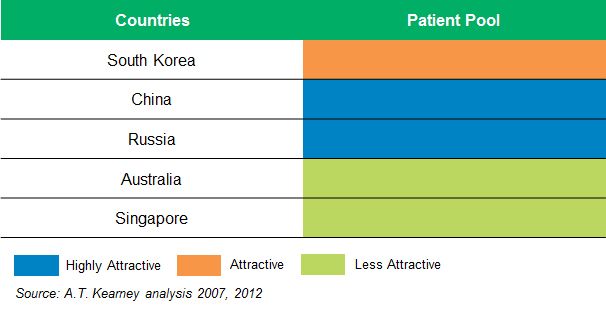
Regulatory & Risk Factors
Regulatory timelines for initiation of Phase I trials, and the overall country risk rating are regarded as the main parameters that need to be understood by pharma before devising any sourcing strategy within a particular country, which includes the following parameters:
Regulatory Timelines
Competitive regulatory timelines is considered as one of the most significant elements in clinical trial conduct. When pharmaceutical companies carry out their category planning, the timelines for assessment and approval is considered as a “key” indication of a country’s attractiveness. The below table summarizes the review timelines and tacit approval across the emerging countries
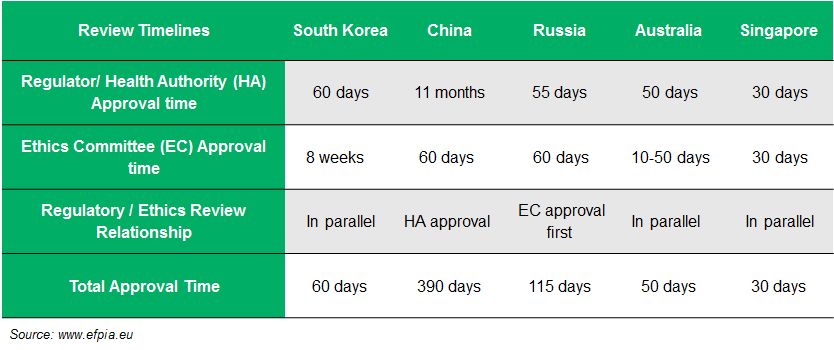
Country Risk
The rise in offshoring clinical services has created a scenario where attention to general country specific risk is required. The Economist Intelligence Unit carries out risk briefings which rates operational risk for several markets. Each country is given an overall score which is an aggregate of the ten categories of risk: Security; Political stability; Government effectiveness; Legal & Regulatory; Macroeconomic; Foreign Trade & Payments; Financial; Tax Policy; Labor Market; and Infrastructure.7 The below table is drawn, which provides the country risk rating across the emerging countries

Next Emerging Destinations:
Based on the above defined supply market and country regulatory & risk parameters, an analysis was carried out where supplier availability, patient pool, regulatory timelines and country risk rating were given a weightage of 40%, 60%, 70% and 30% respectively and scores assigned with 0 being not attractive and 5 being highly attractive. This research and analysis resulted in the below grid.
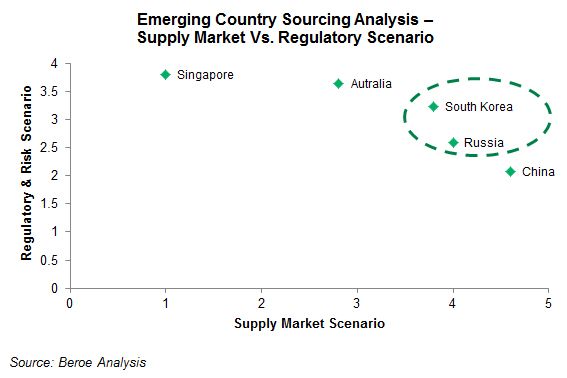
South Korea is found to be the most attractive early phase destination based on the availability of global and regional suppliers, patient pool and regulatory scenario of the country. Russia seems to be moderately attractive with regulatory stringencies being a problem; however, this can be overcome with having partnerships with strong regional or global players with extensive clinical trials experience.
Perspective behind South Korea’s Continued Growth
J. Fred Pritchard, PhD, is one author of this article and the Vice President of Global Drug Development at Celerion, a global CRO with presence in South Korea. Below he provides his perspective on early phase clinical trial conduct in South Korea.
The interest and growth in South Korea in Phase I-IIa studies relative to other areas in Asia, and even relative to the rest of the world, is directly related to the following factors:
- Investment by the South Korean government in developing their biotechnology industry. As part of this nearly 10 year commitment so far, funds were made available to build 15 Clinical Trial Centers (CTCs) at major teaching hospitals. These CTCs have state-of-the-art facilities to perform studies involving confinement of study participants under highly controlled conditions required for many early clinical research studies.
- Highly educated medical and scientific staff interested in early clinical research. Many of the CTCs senior staff spent years abroad in the United States and Europe involved in early clinical research. They now mentor a generation of younger medical scientists who have been educated in medical schools in South Korea that rival the best in the world. Phase I/IIa work is driven by the science behind the new drug candidates and therefore requires highly educated investigators to perform the studies. South Korean scientists are gaining rapidly in credibility among global clinical pharmacologists as reflected by higher numbers of publications in leading medical research journals and presentations at leading scientific meetings for clinical pharmacologists such as ASCPT.
- Access to patients. Early testing in small cohorts of patients to assess safety and see early signs of efficacy or mechanism-of-action are hallmarks of today’s early clinical research strategy. South Korea is a relatively small country by area, but with a relatively large population. Many patients prefer to get treated at large medical centers that they can readily get to. As a result, the hospitals with early CTCs are generally larger than 1000 beds and see as many as 10,000 or more outpatients a day. Recruitment of subjects into early clinical studies where there may be no clinical benefit to the patient is always a challenge for early clinical research studies but having a high volume of patients passing through a modern medical facility containing an early clinical trial center improves the chances of completing a study in a timely way.
- Focus on quality. KoNECT is an organization established several years ago in South Korea to foster collaboration and education of staff within clinical research centers. This has provided access to training programs for GCP and clinical research processes that provide confidence that clinical research work will be conducted to international standards.
- Ever expanding IT infrastructure. South Korea is distant from many global pharmaceutical companies except those in Japan. South Koreans also enjoy the world’s fastest internet and building on their expertise in electronic devices, have created an environment that allows for rapid data and information transfer around the world. This has reduced the barrier of distance considerably.
The above factors have driven a number of CRO’s to expand to South Korea. Celerion recently opened an office within the Seoul National University Biomedical Research Institute in March, 2014. This provides access to our Korean partners to global drug developers through a leading global provider of clinical pharmacology services while providing Celerion’s clients an option to do complex patient studies in a modern research setting.
Therapeutic Area Spread
Around 29% of multinational trials within South Korea focus on “Oncology trials”. Cardiology, CNS, Endocrinology, Infectious and Respiratory diseases are among the other leading therapeutic areas. Many Korean CTCs have excellent alignment with cardiology services including imaging, catheterization, clinical biomarkers that make South Korea a good place to study drugs affecting the cardiovascular system. So, early research in cardiology, although less than oncology, constitutes a high percentage of multinational studies conducted. South Korea also has a somewhat different mix in genotypes for HCV, making it a region of interest to access some patients with genotypes that are very rare in other parts of the world. COPD and asthma, especially related to smoking and air pollution is an issue in South Korea but not nearly the public health concern that it is in China. South Korea has done a great deal to clean up its air and encourage more exercise among Korean people over the past 20 years. Diabetes and obesity associated disease is a growing area as it is in other parts of the modern world and represents a good place to conduct clinical research in this area.
Phase I Patient vs. Phase I Healthy volunteer studies
First-in-Human Phase I Healthy Volunteer studies are performed at South Korean CTCs for about 20-30 new drugs a year. The high majority of these are from the emerging Korean drug discovery or product redevelopment industry that has also enjoyed some significant government support in recent years. For new drug candidates discovered abroad, Korean regulators would prefer to see some human data before agreeing to expose Korean healthy subjects and patients to these products. For this reason and the others cited above, Celerion believes that South Korea is an excellent place to consider for First-in-Patient studies, or as part of a global strategy for early studies of drug effects in appropriate patient populations. The exception is in the area of oncology research where often First-in-Human Patient studies are needed. South Korea has a growing reputation as being a good place to perform such research, again for the reasons of good access to patients, highly trained staff, modern facilities and high quality work.
Bioavailability and Bioequivalence Studies
South Korean CTCs do a certain amount of BA/BE studies but it is believed these are largely to support marketing applications for the domestic Korean market. There is still some uncertainty, globally, whether a BE study done in a predominantly Asian population would be sufficient on its own to support approval of a generic product in countries with predominantly non-Asian inhabitants. While there may be some cost advantage in doing BA/BE studies in Korea, it is not large. Performing work inside China for use in global registrations poses the same issues as doing this work in Korea. In addition, the regulatory timeframe to initiate the work is considerably longer and it is very difficult to export samples outside of the country thereby requiring access to bioanalytical laboratories inside China that can meet rigorous global GLP quality requirements. Finally, the clinical infrastructure for conducting BA/BE studies within China is much less advanced than the CTCs in South Korea. Unless the product is to be sold on the Chinese market, there is little reason to consider doing these studies in China even though costs may be cheaper.
Patient Pool Trend
It is true that access to quality medical care is better in South Korea than in China and Russia, and this does impact the availability of under treated or untreated patients. Much depends on specific protocol inclusion/exclusion criteria as to whether a particular region in the world might offer better access to the type of patient needed in the study. Good access to health care in South Korea also means that patients are more likely to be diagnosed earlier in their disease. This makes it easier to find certain patients, for example those who are managing their Type 2 diabetes with diet and exercise alone or those with mild cognitive impairment. However, specific patient access is only one factor in ensuring successful early clinical studies as you also need to match patient access with quality facilities and well trained medical staff.
South Korea has about the same ability to identify rare patient populations and attract them to clinical research as the United States and some areas of Europe, and this is based again on Koreans having access to modern medical care. There are higher frequencies of some rare HCV genotypes in South Korea. In addition, South Korea has a high incidence of gastric cancers relative to other regions of the world. South Korea has world-leading researchers in pharmacogenomics and this capability helps identify and then diagnose rare forms of disease in the general population
Regulatory Conditions
The South Korean regulatory environment has been largely patterned after the US FDA. This has been fostered over the years by Korean regulatory scientists spending time at the FDA and returning with knowledge of that process. So, MHFS staffers are open to discussion of new drug candidates prior to IND which can facilitate the ultimate review of the IND. South Korean academic experts are often consulted on aspects of mechanism-of-action, safety and efficacy of new drug candidates, so their opinion can be important in guiding new drug development within South Korea.
The long regulatory timelines in China are clearly one deterrent to considering doing early clinical research with new drug candidates whose preclinical development did not occur within China. The only exception would be proof-of-concept studies that might take two years or so to complete and where high access to untreated patients would offset the regulatory delays (e.g. early Alzheimer’s disease studies). The next couple of years should clarify whether studies conducted in South Korea will be accepted by both China and Japan as the three countries’ regulatory authorities agreed in 2012 should happen. If this proves to be viable, then this will stimulate more early clinical research in South Korea.
One of the big advantages Australia has is that for early clinical studies involving administration of drug to healthy subjects, no IND is needed but just an ethics committee approval. Because one can avoid the cost of assembling an IND, many companies will do early SAD studies in healthy subjects, if appropriate, in Australia. The only countries where such regulation exists are The Netherlands, Belgium and Australia.
It would appear that the current political and economic issues in Russia would be a factor for global pharmaceutical companies placing important early clinical research work in the region. Lower costs may not be enough to overcome unease by foreign drug developers in working less stable areas of the world.
References:
- ClinicalTrials.gov. ClinicalTrials.gov. 2011 - 2014.http://www.clinicaltrials.gov/
- Parexel, Stern Agee Estimates. Biopharmaceutical R&D Statistical Sourcebook . Parexel International Corporation, 2013/2014.
- Mansell, Peter. "Early-stage exacerbating trial-cost inflation." PharmaTimes. November 12, 2013. http://www.pharmatimes.com/article/13-11-12/Early-stage_exacerbating_trial-cost_inflation.aspx
- Brennan, Zachary. Outsourcing-pharma. October 16, 2013. http://www.outsourcing-pharma.com/Clinical-Development/Quintiles-shutters-Phase-I-unit-in-India
- Chaturvedi, S. et.al. Outsourcing and Offshoring Trends in Pharmaceuticals. October 2011. https://research.everestgrp.com/Product/EGR-2011-2-R-0600/Outsourcing-and-Offshoring-Trends-in-Pharmaceuticals
- Grichnik, K., Bohnen, H., & Turner, M. Standardized Work - The First Step toward Real Transformation. USA: Booz & Company Inc, 2009. http://www.strategyand.pwc.com/media/file/Standardized_Work.pdf
- Harris Williams & Co.Contract Research Organization Industry Overview: Harris Williams & Co, 2014.
Behind the Buzz: Why Clinical Research Leaders Flock to SCOPE Summit
February 7th 2025In this episode, we meet with Micah Lieberman, Executive Conference Director for SCOPE Summit (Summit for Clinical Ops Executives) at Cambridge Innovation Institute. We will dive deep into the critical role of collaboration within the clinical research ecosystem. How do we bring together diverse stakeholders—sponsors, CROs, clinical trial tech innovators, suppliers, patients, sites, advocacy organizations, investors, and non-profits—to share best practices in trial design, program planning, innovation, and clinical operations? We’ll explore why it’s vital for thought leaders to step beyond their own organizations and learn from others, exchanging ideas that drive advancements in clinical research. Additionally, we’ll discuss the pivotal role of scientific conferences like SCOPE Summit in fostering these essential connections and collaborations, helping shape the future of clinical trials. Join us as we uncover how collective wisdom and cross-industry partnerships are transforming the landscape of clinical research.
Reaching Diverse Patient Populations With Personalized Treatment Methods
January 20th 2025Daejin Abidoye, head of solid tumors, oncology development, AbbVie, discusses a number of topics around diversity in clinical research including industry’s greatest challenges in reaching diverse patient populations, personalized treatment methods, recruitment strategies, and more.